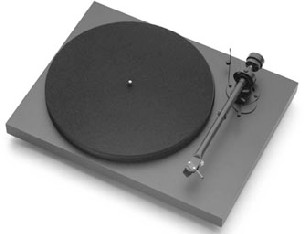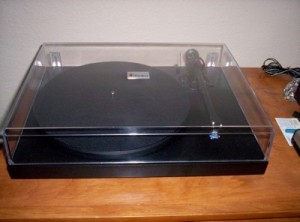Around my household music is enjoyed by everyone, but like me, my eldest son takes his music very seriously. To be sure, many of us start out like my son, taking hand-me down components and adding something new occasionally to build a system. My son’s system consists of a pair Sound Dynamics R-65 two way bookshelf speakers, an Onkyo TX-8211, 50 watt AM/FM stereo receiver and a Music Hall MMF-2.1 turntable with a Goldring Tracker MM cartridge. Most of his CDs are played through a JVC portable or through my old Sony CDP-C50 disc changer and hence he does most of his critical listening by spinning vinyl. A good sounding budget turntable costing less than $200.00 would certainly be a welcomed revelation for those looking to spin records on the cheap. So I began my search in earnest for a great budget table. After several weeks of looking I purchased this Pro-ject 1.2 review sample in good condition on Audiogon for $165.00.
Pro-Ject 1.2 turntable review
The first thing I wanted to see was how a used budget table would sound when compared side by side with my son’s fairly new MMF-2.1. For this portion of the review I mounted the speakers on a pair of 24” high Plateau speaker stands securing them with DAP “Fun Tak” which is similar to, but much less expensive than “Blue Tak”. The stands are filled with lead shot and sand for mass loading and were placed 2 feet from the back wall and 6 feet apart. I toed the speakers in slightly towards the listening position which placed my ears 6 feet back from the front plane of the speakers. For speaker connections I used a 10 foot pair of Zebra ZC SP12SD speaker cables.
The Czech made Pro-ject 1.2 is made in the same factory that produced my son’s Music Hall MMF 2.1. Both turntables are utilitarian in design with solid MDF plinths, metal platters and rubber suspended belt drive motors. Speed selection is made by removing the platter and moving the belt from the larger 45RPM pulley or smaller 331/3 RPM pulley. The power switch is on the left hand side of the table under the plinth on the Pro-ject and on the top of the plinth on the Music Hall. The notable differences between the two turntables are the size and weight of the respective platters and the use of two different tone arms. The Pro-ject comes with a hefty full size 12 inch platter and a slightly longer aluminum tone arm than the MMF 2.1, the MMF 2.1 uses a 10 inch platter that is about half the weight of that used on the Pro-ject table additionally it uses a shorter tone arm that has a plastic head shell. Additionally the MMF 2.1 uses a Goldring Tracker Cartridge and the Pro-ject uses a Sumiko Oyster cartridge, accordingly I knew there would be some differences, but I was really surprised how great they were.
Listening Pro-Ject turntable
I warmed up the system by listening to some of my favorite jazz standards and then used some specific recordings for critical listening, first up was Art Blakey and the Jazz Messengers Blue Note 4003. The first cut on the second side is actually 3 jazz tunes called “The Drum Thunder Suite”, which is usually is a fairly dynamic recording when played on my reference system but it was not nearly as detailed or energetic when played through the MMF-2.1. Switching to the Pro-ject 1.2 brought out more of the life of the recording. Benny Golson’s sax sounded smoother and richer, the drums sounded much more powerful with a more lively presentation. The depth and width of the soundstage were also much greater than when I listened to the MMF 2.1. I switched recordings again, this time cueing up Meet Betty Carter and Ray Bryant Epic Reissue LN3202. My favorite track is “Moonlight in Vermont”, Betty Carter provides a special performance of this jazz standard, she has a rich and smooth voice though at times the recording can sound bright. The thinner sounding Music Hall MMF 2.1 had a compressed sense of space around the vocalist when compared to the Project which again provided a more spacious and dynamic presentation of the music.
One of my favorite Tom Petty albums is Southern Accents. I especially enjoy track one on the album, “Rebels”, which is very well recorded when compared to most of the rock music produced in the eighties. When assessing the performance of both turntables you become much more engaged when listening to the Project 1.2. It produces a sound like rock should sound, more dynamic and powerful. Next I set up the Project 1.2 through my ARC SP16 reference system phono stage. My reference system consists of a VPI HW-19 MKIV turntable, Audio Research SP16 vacuum tube preamplifier, Audio Research VS110 vacuum tube amplifier, Paradigm Signature S2 monitors mounted on Target, lead and sand filled stands. The Speaker Cables of choice are a 10 foot pair of Discovery Cables Essential speaker cables and I also use Discovery Essence interconnects throughout the system. I have my reference turntable set up using a Rega RB600 tone arm and a Clearaudio Beta S MM Cartridge. Presently my listening room is located in our basement it is 13’ X 18’ with 7’8” ceilings. I have positioned the speakers out from the rear wall 42” and away from the side walls about a foot, toed in sharply, on axis to the listening position.
The Project 1.2 sounded quite nice when played through my reference system. It didn’t have the air and sparkle of the VPI HW-19 but it did acquit itself quite nicely, presenting a wide and deep soundstage. I played a copy of the Blue Note 1590 reissue of Candy by Lee Morgan. The VPI HW-19 had a much greater sense of “being there” compared to the Pro-ject 1.2 but there was still a great analog feeling conveyed by the Pro-ject that is almost never present when listening to CDs. While listening to the VPI, Lee Morgan’s Trumpet had a more presence, Doug Watkin’s bass had more weight, Sonny Clarks piano had more clarity and Art Taylor’s cymbal’s had a clear detailed shimmer that floated in space.
I installed a Shure M97XE cartridge on the Project to see what improvement it would make. This ended up being a huge sound improvement over the Sumiko Oyster especially in the areas of resolution and bass response. The Pro-ject 1.2 was much better at conveying the music with the cartridge upgrade.
Conclusion about Pro-Ject 1.2 Turntable
The VPI yields better detail, weight, presence and musicality across the listening spectrum than the Pro-ject 1.2 and not by a small margin, which is as is should be. That said, the Project 1.2 I listened to was superior in every way to the Music Hall MMF 2.1. Regardless of the cost, the Pro-ject 1.2 is a great starter table that can be purchased for a few dollars that would be a great way to move into vinyl playback. Or if you have an older Japanese direct drive turntable in your system, the Project will definitely extract more music from the grooves! If you can find one on Audiogon or e-bay for the right price, it will definitely be worth your while!
Associated Equipment.
- Audio Research SP16
- Preamplifier Audio Research VS110
- Amplifier
- Audio Research SP5 Preamplifier Audio Research D52 Amplifier Primare D30.2 CD Player
- Oppo DV970HD Universal Player
- Pro-ject 1.2 Turntable
- Shure M97XE MM Cartridge Sumiko Oyster MM Cartridge VPI HW19 MKIV Turntable Rega RB 600 Tonearm
- Clearaudio Beta S MM Cartridge Paradigm S2 Signiture Monitors Krix Equinox Monitors
- Discovery Essence Interconnects
- Discovery Essential Speaker
- Cables Eichmann Express
- Six Interconnects Zebra ZC SP12SD
- Speaker Cables Zebra ZC SP14DBI Speaker Cables
external link: Pro-Ject Audio
 from affordableaudio, By Todd Arthur
from affordableaudio, By Todd Arthur

